Don't Forget 93 - Bosnia 2004
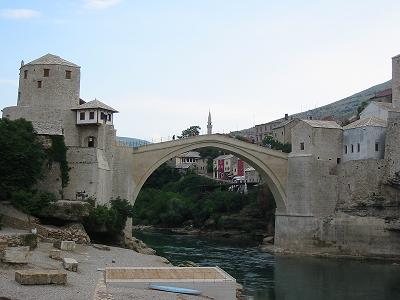
The Mostar Bridge, reopened on July 23, 2004
In the beginning there was Barcelona. In the end there was there was Bosnia. In between there were various variations on a Balkan theme. How we ended up in Bosnia is a story in and of itself – particularly how a planned stay of 12 hours turned into a 4 day vacation. In the last minute, there was a mutiny, and plans for Ljubljana, Zagreb and Serbia were scrapped, leaving Bosnia.
After having traveled around Bosnia for 4 days, I feel that Bosnia has been accorded a bad reputation due to its past. We encountered no difficulties, experienced no hostility, and had nothing but good impressions of the country. Undoubtedly, unexploded ordnance is a problem if you’re not in the least bit careful, but this is no reason not to visit Bosnia. The desire to rebuild the tourist industry is there. The tourists aren’t.
Going to Bosnia is not like going to Afghanistan. There is infrastructure. There has been considerable investment, and much of the country has been rebuilt. The natural beauty alone is a sufficient attraction to bring tourists, but the old parts of the major towns are beautiful themselves and worth visiting.
I hope that my account of my vacation will encourage people to look at Bosnia with a more open mind and consider the possibility that after war, there is hope for rebuilding a vibrant tourist industry.
August 4, 2004
By 6:45 a.m. we are on the road – heading straight for Croatia and then on to Bosnia. I worry about the potential waits at the border – the Hungarians are fond of telling tales of border horror, complete with thorough baggage searches, cavity checks, machine guns, and waits of up to a day and a half. Needless to say, there are no problems. The Hungarian-Croatian border is empty, and the 4 Hungarian and one U.S. passport are quickly examined, only the U.S. passport receiving a stamp from the Croatian border guards. And then we are in Croatia.
Surprisingly, even here, in northern Croatia, signs of the war are everywhere – here an abandoned house, possibly that of a Serb or a Bosniak, there the marks from a spray of machine gun fire. Nevertheless, the majority of houses are well-kept – neat lawns with colorful flowers.
We briefly stop in Ossijek for a cup of coffee and a walk. Here, more buildings are scarred by shrapnel and bullets.
And on we go, towards the Bosnian border. Few of the cars coming in the other direction have Bosnian license plates. In fact, there are few cars coming in the other direction. I begin to worry. What sort of line might await us at the border? Northern Bosnia, being the Serbian part (Republika Srpska), might not have good relations with its Croatian neighbors. They might drag us out of the car and shoot us. At that point I realize that although the line might be long, there is no way the Bosnian border guards regularly shoot travelers. That would probably make the news.
We approach the border. The Croatian border guard flips through our passports before letting us through. Then we come to the line. Truck after truck wait at the border. Of course, as a passenger minibus, we just bypass them all. Here is the Bosnian border. The only other car is a red Lada. Clearly, not many people go to Bosnia. What would they do with our passports? The answer – precisely nothing. A quick flip through them to see the pictures and we’re through.
Bosnia. Since I was a child and saw the first images of the war, I have wanted to come here.
Here it is immediately clear that there has recently been a war. Everywhere there is construction – houses without plaster, built out of red bricks. In front of every house hangs a line with laundry – usually across the second story.
In the Serbian part of Bosnia they use Cyrillic, albeit a slightly strange variation that uses the letter ‘j’. In the south they use the Latin alphabet, a pointed reminder of the fundamental fissure that continues to plague the region.
We stop in Doboj to exchange some money. There is an ATM here that takes Visa. The city is ugly – not because of war, but because of its architecture.
Leaving Doboj, we see the alphabet change. We are now in the Bosnian-Croatian part of the country.
Some of the information I acquired before leaving appears to be outdated. In fact, it is something like traveling through Japan with a 1946 guide book. Some of it is quite correct, however.
Incorrect: There are hardly any gas stations. In fact, new gas stations are springing up everywhere.
Incorrect: The roads are terrible. At least the main roads are quite good, newly repaved and carefully marked.
Correct: The Republika Srpska is much worse off than the south, despite having had fewer scars of war. As soon as we hit the mountainous Bosnian-Croat part, the signs of war become more evident – walls without roofs, gutted houses. At the same time, there is more construction and the houses are better kept. There is clearly the hope of future tourism – hotels, restaurants line the road in the middle of nowhere.
Also correct: Bosnians are terrible drivers. They pass each other at alarming speeds on the twisting, narrow mountain roads. More than once, our driver has to suddenly brake, because in Bosnia, drivers seem to brake at the exact moment when they reach their turning point – not a second before.
Not all settlements have been similarly scarred by the war. Where there are minarets, however, there is a good chance that many of the buildings are new. Most of the minarets, in fact, appear to be prefabs – replacing whatever the Serbs destroyed. There are many new graves in the Muslim cemeteries that we pass.
The scenery is spectacular – it’s a singularly wild, mountainous region. Nature harbors no sign of war. Nestled in the valleys and on the hills, however, are ruined buildings. One especially ruined region is struggling to survive – a few lone houses are being rebuilt amidst the ruins, while a flock of sheep grazes among a meadow that was once the garden of a bombed house.
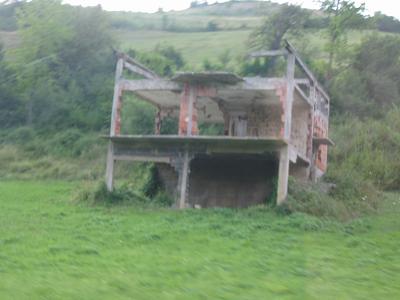
Ruined house on the road to Jajce, picture taken from the car
Many larger towns seem mainly unscarred and you wonder how the war bypassed them, until you notice that most of the buildings are pockmarked and bear shrapnel scars.
Yet everywhere, life goes on. People build 3 story houses and leave the upper 2 stories completely unfinished in hopes of better days to come.
Despite rumors of the unavailability of soft drinks, there are tiny one-roomed stores everywhere, often in the remaining floor of a destroyed house, selling an assortment of chips, Fanta, potatoes and melons.
Towards evening we are still on the road, and in the darkening mountain twilight we see smoke rising eerily from the chimneys. There are no gas lines here – never have been, and electricity is expensive. So they use wood, which is plentiful in the forests. Most of the roadside restaurants have big metal boxes outside, open on one side, in which a whole sheep, head and all, roasts on a spit above a wood fire.
Throughout our travels in Bosnia, many of the cars we see have German, Swiss, Austrian and even Dutch license plates. I do not hear anyone speak any of these languages, and it has become clear that these are Bosnians who work abroad and have come home for their summer vacation. Every now and then you see a German car turn into some unbelievably narrow dirt road, clearly going home to see family.
Finally we reach Jajce, at 7:30 p.m. Along the way we have seen a number of SFOR troops, a reminder of the fragility of Bosnia’s recent peace. The road into Jajce takes us past an electricity generating plant which has an open wall through which you can see the open fires of what appears to be molten iron.
Jajce was pretty badly bombed by the Serbs. Ruined buildings stand at the outskirts of town. We stop at the Hotel Tourist and get two rooms. The rooms are fairly expensive (as I had read before leaving) and rather primitive – the shower has no curtain and the carpet seems to be a remnant of the Communist era. The food in the restaurant is good however, an indicator of food to come – lots of meat and potatoes with a lovely woody flavor. Hysterical giggles ensue over the currency – the Bosnian Mark is called the Konvertible Mark, or the KM. When looking at a menu, or any other prices, the natural instinct is to say that the cost is in kilometers. As a result, for the rest of the stay, we describe everything in terms of kilometers.
We decide to go take a walk. Occasionally, the sidewalk disappears, obliterated by a shell. The old city is at first glance somewhat depressing. We walk among ruined buildings, but where you would expect a gloomy silence, there are sidewalk cafes, blasting music as people mingle and wander in the streets. Life goes on.
August 5, 2004
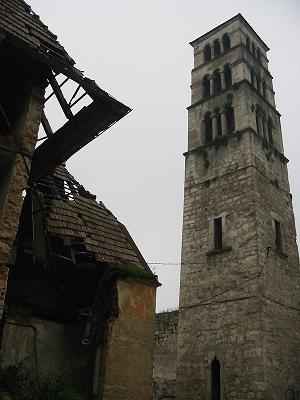
Jajce - old town
The morning brings a heavy misty fog to the valley. We have a 1976 Yugoslavian guide book, which tells us what the sights of Jajce are. This is the first of many such occurrences – many of the sights described in the book no longer exist, destroyed during the war.
There is a certain point when you become desensitized – the ruined buildings no longer catch your eye in the same way. We clamber around some ruins, despite the U.S. travel warnings that ruined buildings should be left alone due to the threat of landmines.
Most interesting are the catacombs, which we are fortunate enough to get a chance to visit. It was in these modest catacombs that Yugoslavia was founded by Tito in 1943. The guide, who spoke English, makes it clear that she much preferred life as part of Yugoslavia, a sentiment that is echoed by others around the country.
And on we go – destination Sarajevo.
Sarajevo has always been a place I wanted to visit, since I read Zlata’s Diary, the story of a young Sarajevo girl, when I was a young girl myself. We wind our way through the mountains, and as we approach Sarajevo it becomes clear that this region was brutally ruined by the war. All of the buildings are new. Many buildings stand empty, deserted by their owners, who either fled elsewhere or were killed. The road into the city is crowded – cars, trucks, SFOR troops – there are many more troops near Sarajevo than near Jajce.
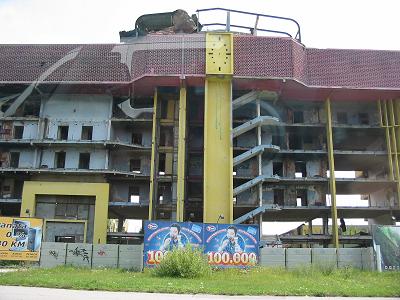
Gutted building at the outskirts of Sarajevo, picture taken from the car
We make it into the city center after passing burned out apartment blocks, department stores and other buildings. The metal roof of one shopping center seems to have melted in despair. The city center is quite the contrast. Obviously there has been investment, and like everywhere else in Bosnia, there are large signboards that advertise who has sponsored the reconstruction – the EU, UNDP, USAID, etc.
We go into the Turkish bazaar where vendors insist on speaking English, and crowds mill. I buy a very tacky souvenir – especially tacky given the sad history of the last decade. It is a pen, made from a rather large bullet casing, with some engraving on it and the words ‘Sarajevo’ and ‘Bosna’ engraved on it.
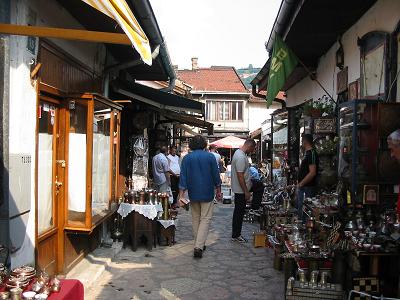
One of the quieter alleys in Sarajevo's Turkish bazaar
Again, I realize that Bosnian food was designed for me. We order cevapi which appears to be ground meat sausages (that look like dog turds) in a big, fried dough pita. Unlike the Lebanese pita, the Bosnian pita is leavened, and awfully good. We finish it off with some Turkish coffee accompanied by a rose-flavored jelly.
The next excitement is the toilet. The toilet consists of a hole with 2 footprints. Luckily I’m wearing a skirt. Meanwhile, the muezzin’s voice blares from the multiple mosques, and scarved women wander the streets.
Sarajevo is so lively in the bazaar area that it is easy to forget that there has been a war. The hilly nature of the city means that it is easy to avoid seeing past the rebuilt areas. We only spend a short amount of time there, before heading on to Mostar. I promise to myself that I will definitely come back here at a later date and explore it further.
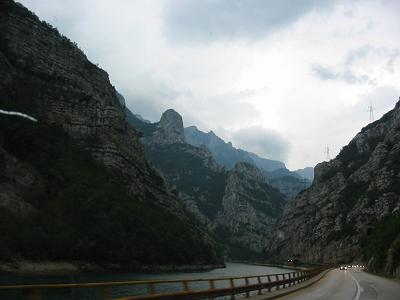
The road to Mostar, picture taken from the car
The road to Mostar is incredible. Its natural beauty is unbelievable, reminiscent of a very wild Switzerland, with smaller mountains, fewer houses, fewer people and scars of war. It is at this point that I decide that someday I will have a summer house in Bosnia. Somewhere in the mountains. Something simple, so that if it is ever bombed, I can easily rebuild it.
It is early evening as we approach Mostar, and it is raining. For miles now, there have been shattered buildings lining the roadside and the hills. Not one building appears to have survived intact. Somehow none of this sinks in until we enter Mostar. As we drive through the city, we realize that almost every building is a shell. Many are under construction, but few are more than a few walls. I have never seen such total annihilation. All of the destroyed houses that we have seen until now seem meaningless in comparison to the scale of Mostar’s destruction.
We drive around looking for a hotel when a man on a motorscooter comes up to use and greets us in Hungarian. He indicates that he wishes to talk, so we pull over. Are we looking for a place to spend the night, he asks in German. Yes, we say. He tells us to follow him and he’ll take us to a place where we can get lodging. It’s very clean, he says, and new. It is 250 meters from the old bridge.
At the moment our only other option is the large Communist-era hotel we saw coming into the city. After last night’s Communist-era hotel, however, we’re ready for a change.
We follow him through the winding streets and finally get there. Instead of 250 meters it is about 1 kilometer from the old bridge, but that doesn’t matter.
We take a look at the place. It is right off the main highway, and is a newly reconstructed building with a shop underneath. The place is indeed clean, and new. The bedroom are Spartan, but what else would you expect in Mostar after a war. We ask the price, and are told that if we pay upfront we don’t have to give our passports. Like everywhere else in Bosnia, the Euro is as much the currency as the Mark. In fact, there have been occasions where change is given in Euros. The Bosnian Mark is fixed to the Euro so that 1 Mark = 0.5 Euro.
After paying, we realize that the hotel is locked from the outside every night from 11 p.m. to 6 a.m. This is not acceptable. I explain to the man that my mother does not want to be locked up and that we need a key. He makes a phone call, agrees that we’re right, and says that by 9 p.m. there will be a front door key for us in the store below, which is open until 10:30 p.m.
As we enter the hotel again, the power goes out. Somehow, this is not surprising. I go outside and down to the shop where one of our traveling companions is buying a watermelon by candlelight. An elderly Muslim woman holds the candle as he taps the melon. This is somehow perfectly appropriate for Mostar.
A few minutes later the lights come back on.
We eat the watermelon on the balcony of our room. I still can’t believe I’m in Bosnia – and not only am I in Bosnia, but in Mostar.
We head out to find some food. It is dark out, and there are giant locusts. We come to a clearing where amongst the ruins we have a perfect view of the newly rebuilt bridge of Mostar. The bridge is lit up, and from where we stand, we can see crowds of people thronging on the bridge, staring out in wonderment. The sight sends shivers down my spine. More than anything, the destruction of this bridge was the symbol of the senseless destruction that accompanied the Bosnian war. It has only been open for two weeks, and Bosnians are flocking to Mostar to admire it and celebrate peace. The human spirit refuses to be suppressed.
There is a great deal of life in Mostar at night. All of the shops and cafes are open until late, and people are out in large numbers. After dinner, and some Sarajevsko beer, we head out for a walk. The old part of town on either side of the bridge has been largely rebuilt, and with the crowds of people, the music and the darkness, it is hard to imagine that most of the city is still in ruins.
We arrive back at the hotel, where we have a key to the front door and retire for the night. Again, I cannot help but marvel at how life goes on and as I fall asleep on the child-sized bed (I have the third bed in the three-bed room) I feel certain that I will return to Bosnia many more times.
August 6, 2004
We wake up early in the morning and go out to see Mostar by daylight. By daylight, the damage is more visible – only the very heart of the old town has been rebuilt. The rest is still mostly ruined.
The bridge is as beautiful in the morning as it was at night. I notice that there is a stone, one of the original stones of the old bridge, lying at the foot of the bridge that says “Don’t Forget 93.” It’s hard to forget it when so much of the city is scarred.
As in Sarajevo, the Turkish bazaar is jumping, with vendors selling souvenirs of various types. I buy a T-shirt that says “Mostar” with a picture of the bridge and “Bosna Herzegovina” underneath it.
Throughout the trip, I have been drinking inordinate amounts of coffee – Bosnian coffee is strong and flavorful, both when served as espresso and when served as Turkish coffee. Today is no exception.
We wander around Mostar, enjoying the vibrant life and the rebuilt buildings. We even visit a mosque before stopping for lunch.
Lunch is exquisite – a very long dough stick stuffed with ground meat and onions. Hard to describe, but really a perfect combination of flavors.
Close to the old town is a market, and we marvel at the variety of fruits and vegetables. Everything is huge, fragrant, and unusually attractive. Some of the selections are unfamiliar – someone is selling something that looks like miniature okra. At another stand I wonder what the giant plastic bag of herb looking stuff is. We at first think it’s tea, but the vendor manages to convey to us that it is an enormous bag of freshly dried Balkan tobacco.
Past the market is a butcher, and in the window hangs an entire dead sheep – head, teeth, eyeballs – everything. We go inside, where there is a big selection of different cuts of meat, internal organs, and a whole cow’s head, again with teeth and eyeballs.
As we move away from the old town we see more and more destroyed buildings, as well as another lovely mosque where we run into the man who directed us to the hotel. He gives us a discount rate to look at the mosque, which we do.
Across the street from the mosque is one of the most haunting sights of the trip. A brand new Muslim cemetery, where every gravestone’s date is 1993, except for the few that read 1994. Since the bridge was blown up on November 9, 1993 (by the Croats – I have given up trying to understand who blew up what when and how during that war), I feel especially sorry for those who suffered for a few more months before dying in 1994. Some of the gravestones are of people born in 1980, like me. One is of someone who was born and who also died in 1993. Throughout the countryside of Bosnia, there are many new cemeteries, particularly Muslim ones. This is the first one we’ve seen up close.
The closer we get to the periphery of the city center, the more destroyed the buildings are. I look up at one, an ugly Communist era building, and notice that it has “Happy New Year” written across the top. Happy New Year indeed.
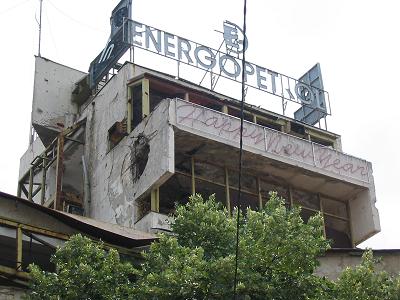
Mostar - Happy New Year building
Further on, we come to a major square. Every building in the square has been destroyed. One of these buildings is the former music school. They are trying to rebuild it, but a sign says that they are still looking for investors. War does not come cheap.
Mostar does have its more cheerful aspects. Namely, its cats. Mostar, being a mountain town, seems to have developed a purebred local cat that looks remarkably like an Abyssinian, with a long face and fine limbs. It comes in different colors and markings, and is clearly a street cat. I surmise that centuries of inbreeding have made it such a beautiful and unique species.
The cats are extremely sociable, and enjoy being scratched. I begin to hatch a plan – next time I go to Mostar, I will take a couple of female and a couple of male cats back with me and begin to breed them. I will start a new breed of cat – the Mostar cat. The purpose – to help rebuild Mostar. I will breed the cats and sell them at a high price and send a majority of the profits to the citizens of Bosnia. Americans love helping people. I would make money, Bosnia would benefit, and I would have lots of pretty cats.
After spending a few hours in Mostar, we leave, headed for a town called Positej which has a ruined medieval castle (not war ruins, just old ruins) on the top of a hill.
This small village is architecturally fascinating. There are no roads – everything is built into the hill, and the paths that lead up are all stairs. Many of the buildings here are under construction – even this tiny place suffered during the war. Of course, since there are no roads, the citizens have to reconstruct everything manually.
We climb up to the castle and look down at the river and the town below. The view is spectacular – so tranquil that it is impossible to imagine any violence occurring here.
From Positej we head back towards Jajce on a different road, beginning our slow return towards Hungary. My head spins with everything I’ve seen, and I continue to gaze out of the car window at every passing sight. By the time we reach Jajce I’m exhausted.
In Jajce we decide to try the other hotel in town, since we were not overly enthusiastic about the Communist one. The hotel turns out to be brand new, beautifully appointed, with completely Western fixtures, and is a lovely change. Luxury is sometimes necessary.
My mother, our driver and I share a suite – the theme of the suite is Tito. Apparently every room in the hotel has a theme – ours happens to be Tito. There are pictures of him everywhere, and a small bust of him on the writing desk. It is palpable in Bosnia that people yearn for the old days – the days of Tito. This merely reinforces that impression.
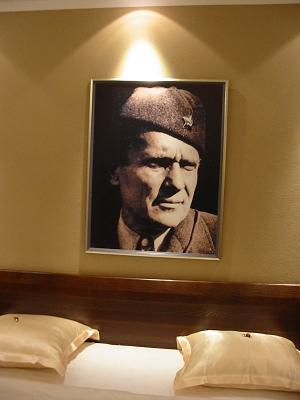
Jajce - The Tito Suite
I conk out early – I’ve already seen Jajce, both by day and by night, and I’m tired. I have seen more in a few short days than I usually do in a year. My eyes are simply incapable of staying open any longer.
August 7, 2004
We take things easy in the morning as we get ready to head back to Hungary – this time through Banja Luka.
The road is beautiful – they all have been. We are fairly focused on driving – it is a 12 hour drive, and we’re all fairly tired.
Surprisingly, Banja Luka is rather beautiful, although it irks me that as we pass through it I see no scars of war whatsoever. It seems unfair that when so much of the country was ruined, Banja Luka managed to get away without major damage due to it being a Serb city.
As we drive through Banja Luka I see an even more irksome piece of graffiti – “I’m proud of myself because I’m a Serb” – perfectly written in English. Tensions definitely remain in Bosnia.
The border crossing is again a breeze – the Bosnians don’t even look at our passports, and the Croats are also very quick.
Since we are taking a different road through Croatia, we pass different towns. This region has been heavily hurt by the war. Parts of it look worse than Bosnia. In one town, in particular, it appears that every single building was destroyed. Driving through the town we come across a long row of wooden barracks by the railroad tracks – temporary housing put up by relief agencies for the homeless citizens. Nevertheless, the temporary housing is emptying as people rebuild their houses, often in front of the ruins of their old houses.
Our return to Hungary comes so swiftly that I have to stop and wonder whether this whole trip was real. The thought that I finally have seen Sarajevo after all of these years, and have traveled through Bosnia by car is somehow unreal to me.
Some might expect me to become a pacifist after this trip. I’m not. I saw what war can do, and it isn’t pretty. But then again nobody ever told me it was pretty. What I gleaned from this trip is that humans are destined to survive – we’re the mammalian equivalent of cockroaches – you spray Raid all over us, some of us die – but we’ll be back – in the same places we were before. And this is a great thing. It’s a validation of not only mankind’s existence, but also my own personal existence, and it makes me realize that no situation should ever be treated as hopeless or as impossible.
Besides – Bosnia is just plain gorgeous. And that’s as good of a reason as any to go back and visit frequently.
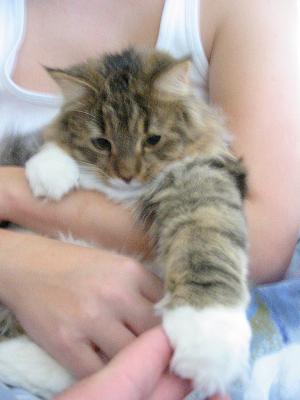

4 Comments:
Thank you. The descriptions are wonderful and well written. I am very sorry I was not along to experience and enjoy it with you.
That was an awesome read. Thanks for taking the time to put it all down.
Thieus
Thank you.I am happy you had fun and enjoyed the trip throught Bosnia & Croatia and i hope you have good trips always :)
Thank U for the read :)
Post a Comment
<< Home